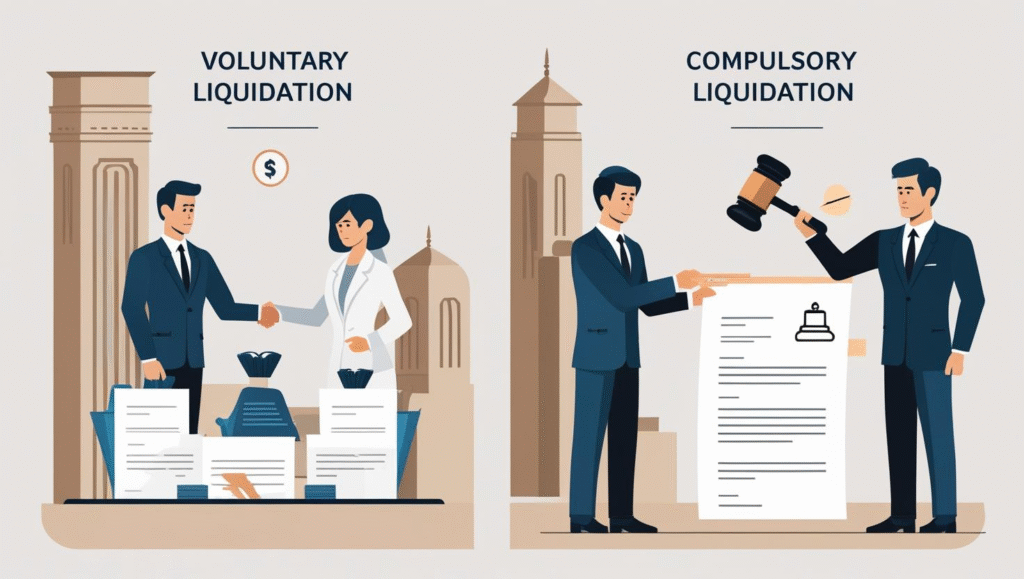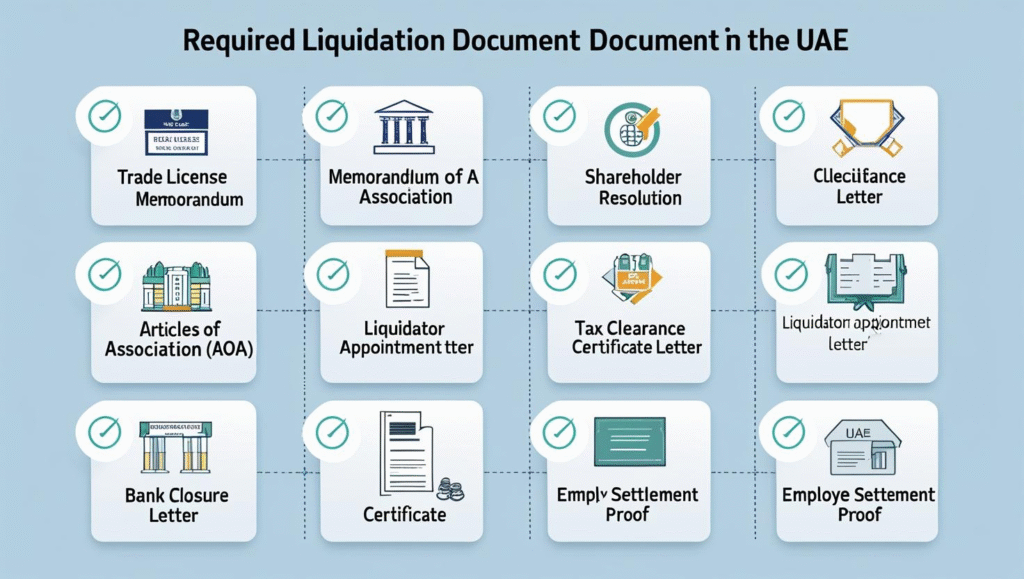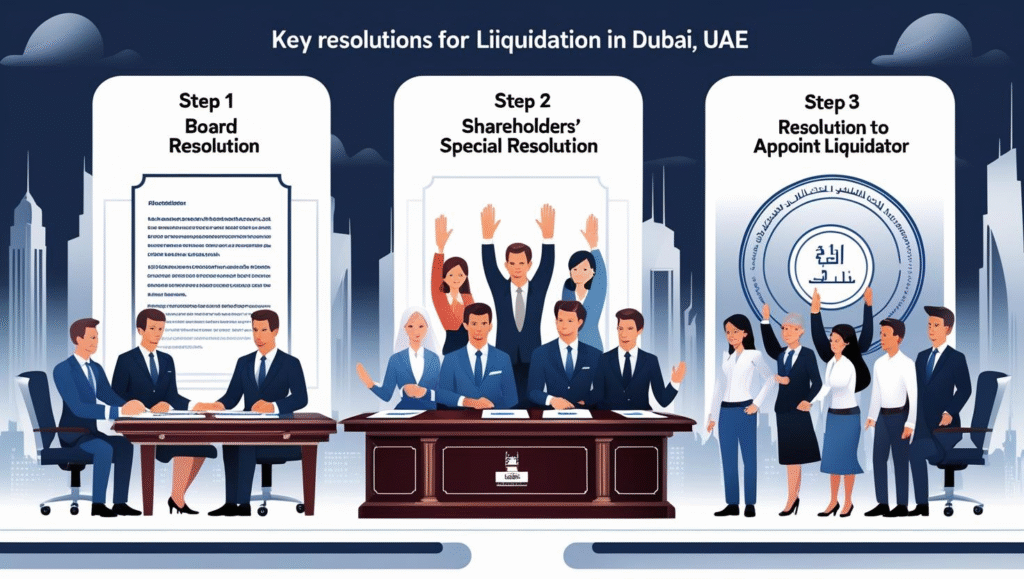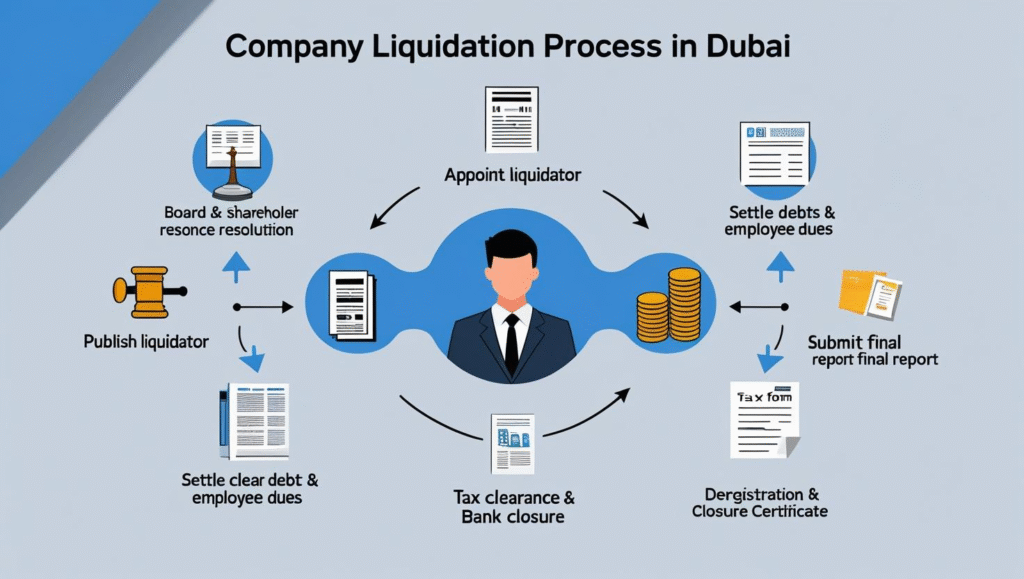Closing a company is not always a walk in the park. Many owners feel lost because they don’t know which papers are needed, what approvals to take, or how to follow the rules. This confusion can lead to fines, delays, and extra stress. The simple answer is to understand the right documents and plan each step carefully.
This guide will explain all the important liquidation documents and resolutions you need to close a company. We will show you, step by step, which papers are required and why they matter. With this checklist, you can make the process smooth and safe. If you are planning to shut down your business, this guide will help you start in the right way.
Why Documents and resolutions required for company liquidation
When closing a company, documents and resolutions act like the keys to the door. Without them, you cannot complete the process. Every authority in the UAE, whether it is the Department of Economic Development, free zone authority, or tax office, will ask for specific papers before approving your closure.
These documents show that the company has cleared its debts, paid its staff, and followed the law. Resolutions, on the other hand, are official decisions made by the board and shareholders. They prove that the owners agree to shut down the company and appoint a liquidator. Without these resolutions, the process is not valid.
Having all documents ready not only saves time but also protects the owners from future legal or financial claims. It ensures that the company is fully closed in the eyes of the law, with nothing left pending.
Understanding Company Liquidation

Types of Liquidation
There are two main types of company liquidation:
Voluntary liquidation
This happens when the owners themselves decide to close the company. It can be done if the company is solvent (able to pay its debts) or insolvent (not able to pay debts). In both cases, the process requires formal documents and resolutions.
Compulsory liquidation
This happens when a court orders the company to shut down, usually because of unpaid debts, legal disputes, or violations. In this case, the court appoints a liquidator, and the required documents may be different from voluntary closure
How Liquidation Type Affects Required Documents
The type of liquidation decides which documents are needed. For voluntary liquidation, the focus is on shareholder and board resolutions, appointment of a liquidator, and financial clearance papers.
For compulsory liquidation, extra documents are required from the court, creditors, and sometimes government regulators. The process is usually longer and stricter, as it involves more parties and legal checks.
Knowing the type of liquidation early helps in preparing the right documents and avoiding last-minute surprises..

Key Liquidation Documents Checklist
When closing a company, preparing the right papers is the most important step. These documents act as proof that the company has followed the law, cleared debts, and completed all responsibilities. Below is a detailed breakdown of each type of document you need.
Company Identity and Registration Papers
- Trade License / Certificate of Incorporation
This is the official license that allows your business to operate. Without submitting this, the authorities cannot confirm that your company existed legally. In the UAE, your trade license comes from the Department of Economic Development (DED) for mainland companies, or from the Free Zone Authority if you are in a free zone. - Memorandum & Articles of Association (MOA & AOA)
These documents show how your company was set up. The Memorandum lists the shareholders and their shareholding percentage, while the Articles explain how the company will be managed. During liquidation, these are checked to make sure the closure follows the original company rules.
Shareholder Register
This is a list of all shareholders and their shareholding. It helps the liquidator and regulators confirm ownership. It is also used to ensure that all shareholders agree on the decision to liquidate.
Governance Documents
- Board Resolution for Liquidation
This is the first official step. The company’s directors pass a resolution (decision) to propose the closure of the company. It normally includes reasons for liquidation and a note that the company can pay off its debts (if solvent). - Shareholders’ Special Resolution
Shareholders hold a meeting and sign a resolution that confirms their approval to liquidate the company. In the UAE, this usually requires approval from at least 75% of shareholders. This resolution is then notarized and filed with the authority. - Power of Attorney (if appointing an agent)
Sometimes, the directors or shareholders give authority to a lawyer, consultant, or another person to handle the liquidation process on their behalf. A Power of Attorney must be legally signed and, in some cases, attested.
Liquidator Appointment Documents
- Appointment Letter / Consent Form
A liquidator is a licensed professional who handles the entire closure process. An official letter is issued by the company to confirm the appointment, and the liquidator provides a consent letter agreeing to take the job. - Regulator or Court Filings
Once a liquidator is appointed, the details must be registered with the regulator (DED, Free Zone Authority, or Court). This ensures the liquidator has full legal authority to act on behalf of the company.
Financial and Tax Documents
- Latest Audited Financials
The most recent audited accounts show the financial position of the company. This includes assets, liabilities, income, and expenses. These are important because creditors and regulators need to know the company’s financial status before closure. - Statement of Affairs / Management Accounts
If audited accounts are not available, a Statement of Affairs or management accounts prepared by the directors can be submitted. This statement lists the company’s debts, assets, and obligations, giving a clear picture to the liquidator. - Final Tax Returns and Clearance Certificates
In the UAE, all companies must submit final VAT returns (if registered) and request a Tax Clearance Certificate from the Federal Tax Authority (FTA). This proves that no tax is pending. Without this, liquidation cannot be completed.
Closure and Clearance Documents
- Bank Account Closure Letters
All company bank accounts must be closed before liquidation is finalized. Banks issue official closure letters confirming that accounts are closed and no money is left pending. - NOCs from Utilities, Landlords, Telecom Providers
A No Objection Certificate (NOC) is needed from utility companies (like DEWA in Dubai), landlords, and telecom providers. These letters confirm that all bills are paid and no dues are outstanding. - Employee Settlement Proofs and Visa Cancellations
If the company had employees, their end-of-service benefits must be paid, and their visas cancelled. The Ministry of Human Resources and Emiratisation (MOHRE) and immigration authorities provide clearance once all obligations to employees are met.
Public Notices and Regulator Filings
- Newspaper / Gazette Notice of Liquidation
In the UAE, companies must publish a notice of liquidation in at least two local newspapers. This gives creditors 45 days to raise any claims. If no claims are made, the process continues smoothly. - Application for Strike-Off or Deregistration
This is the final application to remove the company from the commercial register. It is submitted to the authority (DED or Free Zone Authority). Once approved, the company is legally dissolved.
Liquidator Report
- Interim Reports to Creditors
During the process, the liquidator may prepare interim reports that update creditors about the status of asset sales, debt payments, and claims received. - Final Liquidation Report with Receipts and Payments
This is the most important report. It is a full summary of how the company’s assets were sold, how debts were cleared, and what balance (if any) was returned to shareholders. This report is submitted to the authority for final approval of liquidation.
With these documents in place, a company can move smoothly through liquidation without facing delays, penalties, or disputes.

Resolutions Required for Liquidation
Apart from legal documents, resolutions are equally important in company liquidation. A resolution is simply a formal decision made by the board of directors or the shareholders. These resolutions prove that everyone agrees with the decision to close the company and that a liquidator has been appointed. Without these, the authorities will not approve the liquidation.
Board Resolution
A board resolution is the first step. It is passed by the directors of the company in a board meeting. This resolution usually states:
- The decision to liquidate the company
- The reason for liquidation
- Permission to call a shareholders’ meeting for approval
The board resolution should be signed by all directors. It shows that the directors agree to begin the closure process.
Shareholders’ Special Resolution
The shareholders’ resolution is the most important one. In the UAE, shareholders must pass a special resolution, which usually requires at least 75% approval.
This resolution should include:
- The agreement of shareholders to liquidate the company
- The appointment of a liquidator
- The authority given to directors or an agent to complete the process
It must be notarized and submitted to the regulator. Without this resolution, liquidation cannot proceed.
Resolution to Appoint Liquidator
This resolution officially confirms the choice of the liquidator. It mentions:
- The name of the liquidator
- The powers given to the liquidator (such as selling assets, paying debts, preparing reports)
- Consent from the liquidator to accept the role
The resolution is filed with the relevant authority (DED or Free Zone Authority). Once accepted, the liquidator gains legal power to act on behalf of the company.
Resolution to Appoint Liquidator
When writing resolutions, a few simple practices make the process smoother:
- Use clear and simple wording so there is no confusion
- Include the full company name, trade license number, and details of directors/shareholders
- Make sure all signatures match the company records
- Submit copies to the regulator, bank, and liquidator
Common mistakes to avoid: spelling errors in company details, missing signatures, or vague wording. These can cause the resolutions to be rejected.
Resolutions are the backbone of the liquidation process. They show unity among directors and shareholders, and they legally empower the liquidator to act.

Liquidation Documents Step by Step
Liquidation is not just about collecting papers; it follows a proper order. Each stage needs specific documents. Here’s a simple breakdown of the process from start to finish.
Resolution to Appoint Liquidator
Before starting liquidation, the company must prepare:
- Solvency Statement (if applicable): If the company can pay its debts, the directors sign a solvency declaration. This shows creditors that the business is not running away from obligations.
- Draft Resolutions: Draft copies of the board and shareholders’ resolutions to approve liquidation.
- Due Diligence Documents: Gather identity proofs of shareholders, trade license, and MOA/AOA for the liquidator to review.
This stage is about planning and collecting the basics.
Resolution and Appointment Stage
At this stage, the company makes the decision official.
- Signed Resolutions: The board and shareholders pass and sign resolutions for liquidation.
- Liquidator Consent: A letter from the liquidator confirming acceptance of the role.
- Regulator Notifications: Submitting the resolutions and liquidator appointment to the Department of Economic Development (DED) or Free Zone Authority.
This is where liquidation formally begins.
Creditor Engagement Stage
Creditors (people or companies the business owes money to) must be informed.
- Public Notices: A liquidation notice is published in two local newspapers. Creditors are given 45 days to submit claims.
- Proof of Debt Forms: Creditors may send official forms showing how much money is owed to them.
- Creditor Communications: The liquidator must keep records of all claims and communications.
This stage protects both creditors and the company by ensuring everything is transparent.
Settlement Stage
Now the company starts clearing all obligations.
- Asset Sales: If the company owns assets (equipment, property, vehicles), they are sold to pay debts.
- Employee Settlements: All staff dues, including salaries and end-of-service benefits, must be cleared.
- Tax Filings: Submit final VAT returns and get a Tax Clearance Certificate.
At this stage, the company proves that all debts, taxes, and employee rights are settled.
Final Closure Stage
The last stage confirms the official closure.
- Liquidator’s Final Report: A full summary of receipts, payments, and settlement of debts.
- Strike-Off Application / Deregistration: Submitted to the authority to remove the company from the commercial register.
Official Closure Certificate: Once approved, the company is legally dissolved and cannot trade anymore.
This is the final confirmation that the company has completed liquidation successfully.
Following these steps in order makes the process smooth and ensures that no important document is missed.
Common Mistakes in Document Preparation
When liquidating a company in the UAE, even a small mistake in paperwork can delay the process by weeks or even months. Many business owners overlook details that later create big problems. Here are the most common mistakes to avoid:
Missing Signatures
Documents like the board resolution or liquidator appointment must be signed by all required parties. If even one signature is missing, the authority will reject the file.
Submitting Expired Passports or IDs
Authorities only accept valid documents. If a shareholder’s passport or Emirates ID has expired, you must renew it before submission.
Forgetting VAT/TAX Clearance
Companies registered with VAT need clearance from the Federal Tax Authority. Many owners skip this step, but without it, liquidation cannot move forward.
Not Cancelling Employee Visas
Active visas linked to your company must be cancelled first. If not, you may face penalties and your liquidation request will be put on hold.
Incorrect or Incomplete Audit Report
If a liquidator’s report is required, it must include all company accounts up to the final operating date. A report with errors or missing details can cause delays.
Skipping Newspaper Publication Proof (for Mainland Companies)
If liquidation is not announced publicly (in two newspapers), the DED will not approve the process.
Tip: Always double-check every document and keep a checklist. Hiring a professional service can save you from costly mistakes and wasted time.
Timeline and Costs of Liquidation
Closing a company in the UAE is not something that happens overnight. The process has clear steps, and each step takes time. The total duration and cost depend on the type of company (mainland, free zone, or offshore), and whether your documents are complete.
Typical Timeline
- Free Zone Company – Usually takes 2 to 6 weeks if all documents are in order. Some zones are faster, while others may take longer because of internal approvals.
- Mainland Company – Takes 6 to 8 weeks since it involves government departments like the DED, immigration, labour, and tax authority.
- Offshore Company – Can be completed in 2 to 4 weeks, as there are fewer requirements.
Delays often happen when owners forget to cancel visas, miss tax clearance, or fail to submit a correct liquidator’s report.
Costs Involved
The cost of liquidation also varies depending on your company setup. Some common expenses include:
- Government fees – Paid to authorities for processing your closure request.
- Liquidator’s fee – For preparing the final report (required for mainland and some free zones).
- Clearance costs – For cancelling utilities, leases, and employee visas.
- Advertisement fees – If you are a mainland company, you must publish your closure notice in two newspapers.
Why Costs Vary
If your company has no debts, employees, or office rent, the process will be cheaper and faster. However, if there are outstanding liabilities, the process becomes more complex and costly.
Tip: Always prepare your finances in advance. It is better to budget slightly higher than expected, so you don’t face surprise costs during liquidation.
Conclusion
Closing a company in the UAE may feel like a mountain to climb, but with the right steps and documents, it becomes much easier. We have covered everything you need to know, from understanding liquidation to the required paperwork and why professional support makes a difference.
At the end of the day, proper liquidation protects your reputation, saves you from penalties, and gives you a fresh start for your future plans. Instead of struggling alone, let experts guide you smoothly through the process.
If you are planning to legally liquidate a company in Dubai, our team at Capital Closure is ready to help. With years of experience, we make sure every detail is handled quickly and correctly.



